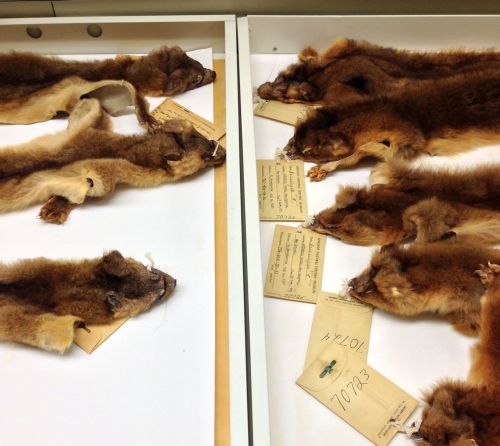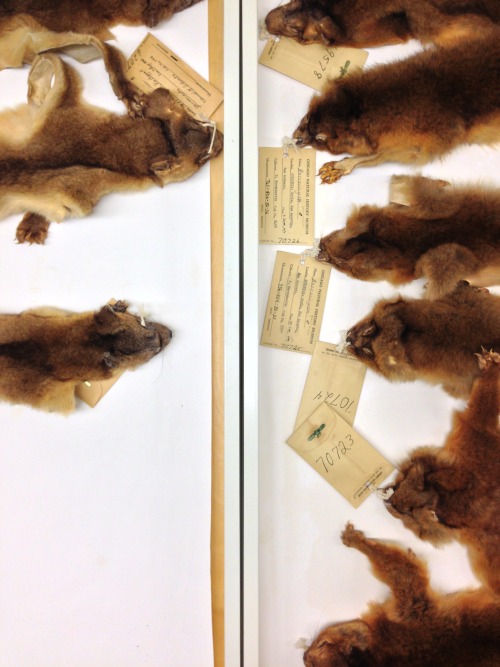Imagine a mini-raccoon with a teddy bear face that is so cute it's hard to resist, let alone overlook. But somehow science did — until now.
Researchers announced Thursday a rare discovery of a new species of mammal called the olinguito. The reddish-brown animal is about 14-inches long with an equally long tail and weighs about 2 pounds.
It belongs to a grouping of large creatures that include dogs, cats and bears.
The critter leaps through the trees of mountainous forests of Ecuador and Colombia at night, according to a Smithsonian researcher who has spent the past decade tracking them.
But the adorable olinguito (oh-lihn-GEE'-toe) shouldn't have been so hard to find. One of them once lived in the Smithsonian-run National Zoo in Washington for a year in a case of mistaken identity.
"It's been kind of hiding in plain sight for a long time" despite its extraordinary beauty, said Kristofer Helgen, the Smithsonian's curator of mammals.
The little zoo critter, named Ringerl, was mistaken for a sister species, the olingo. Before she died in 1976, Ringerl was shipped from zoo to zoo in Louisville, Ky., Tucson, Ariz., Salt Lake City, Washington and New York City to try to get it to breed with other olingos.
She wouldn't.
"It turns out she wasn't fussy," Helgen said. "She wasn't the right species."
The discovery is described in a study in the journal ZooKey.
Helgen first figured olinguitos were different from olingos when he was looking at pelts and skeletons in a museum. He later led a team to South America in 2006.
"When we went to the field we found it in the very first night," said study co-author Roland Kays of the North Carolina Museum of Natural Sciences. "It was almost like it was waiting for us."
It's hard to figure how olingos and onlinguitos were confused for each other.
"How is it different? In almost every way that you can look at it," Helgen said.
Olinguitos are smaller, have shorter tails, a rounder face, tinier ears and darker bushier fur, he said.
"It looks kind of like a fuzzball ... kind of like a cross between a teddy bear and a house cat," Helgen said.
It eats fruit and has one baby at a time. Helgen figures there are thousands of olinguitos in the mountainous forest, traveling through the trees at night which makes them hard to see.
While new species are found regularly, usually they are tiny things like insects and not mammals, the warm-blooded advanced class of animals that have hair, live births and mammary glands in females.
Outside experts said this discovery is not merely renaming something, but a genuine new species — with three new subspecies. It's the type of significant find that hasn't happened in the Americas for about 35 years.
"Most people believe there are no new species to discover, particularly of relatively large charismatic animals," said Case Western Reserve University anatomy professor Darin Croft. "This study demonstrates that this is clearly not the case."
The olinguito is the smallest member of the raccoon family of mammals.
The researchers only saw olinguitos in Ecuador and Colombia, but they said they could also be living in parts of Panama, Costa Rica, Venezuela, Brazil, Peru, and Guyana, based on their cloud forest habitat.
The olingo is also native to Central and South America.
The North Carolina museum is already selling olinguito stuffed animals for about $15. Proceeds will benefit habitat preservation for the creatures.
New Carnivore Found Hiding in Plain Sight
Moderator: Alyrium Denryle
New Carnivore Found Hiding in Plain Sight
Me: Nope, that's why I have you around to tell me.
Nitram: You -are- beautiful. Anyone tries to tell you otherwise kill them.
"A life is like a garden. Perfect moments can be had, but not preserved, except in memory. LLAP" -- Leonard Nimoy, last Tweet
- Vehrec
- Jedi Council Member
- Posts: 2204
- Joined: 2006-04-22 12:29pm
- Location: The Ohio State University
- Contact:
Re: New Carnivore Found Hiding in Plain Sight
Another perspective on this discovery from the Field Museum's Chief Curiosity Corespondent.thebrainscoop wrote:
Olinguito
On Tuesday, Bill Stanley grabbed my arm and pulled me into a side hallway as we were walking towards the mammal collections on the third floor. He looked around suspiciously before leaning in, and in a hushed tone he said
there’s a new raccoon.
What do you mean?
There’s a new raccoon. You can’t tell anyone. It’s in the pipeline. Going live on Thursday.
Wha- I wasn’t going to-
You can’t tell anyone. Guess where it was discovered?
Oh, geez. I don’t know. Maybe Per-
Here. It was discovered here.
Then he patted my shoulder, winked, and kept walking.
Such was my introduction to the olinguito - and yesterday Bill brought it out to show me. In front of us were two drawers, one with the previously known species and the newly described animals on the right. It was immediately obvious to me that before us were two different animals - the size, color and length of the fur, the size of the ears - but without the previous knowledge that they were not one in the same, would I have seen the same dissimilarities?
This is what sparks me. This is what drives my enthusiasm. In these drawers for sixty years, side-by-side these animals remained, their full potential not realized until a curious researcher took the quiet time to sit down and take a concentrated look at them. It’s the romance of the discovery — it was here all along! — and once you see the striking inconsistencies there comes a feeling of empowerment, the thought that we are the next big discoverers. The thrill of the breakthrough remains attainable, accessible. It’s not beyond our reach or out of grasp - I look forward to seeing what you find next.
 Commander of the MFS Darwinian Selection Method (sexual)
Commander of the MFS Darwinian Selection Method (sexual)

